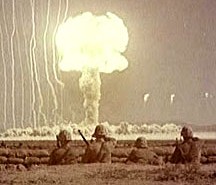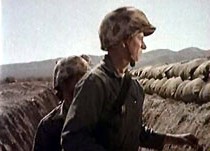 |
|
Operation Tumbler-Snapper - 1952

Dog - 01/05/1952
|
Operation Tumbler-Snapper was planned and conducted to diversify and thus strengthen the U.S. nuclear arsenal. The continuing development of nuclear technology was deemed important because the postwar defense policy of the United States rested largely upon nuclear weapons rather than a large standing army. The Chairman of the Atomic Energy Commission strongly advocated the development of nuclear devices for tactical purposes.
"What we are working toward here is a situation where we will have atomic weapons in almost as complete a variety as conventional ones...This would include artillery shells, guided missiles, torpedoes, rockets and bombs for ground-support aircraft....We could use an atomic bomb today in a tactical way against enemy troops in the field, against military concentrations near battle areas and against other vital military targets without risk to our own troops. We are steadily increasing, through our technological and production progress, the number of situations in which atomic weapons can be effectively employed in battle areas."
- AEC Chairman |1951|
|
Tumbler-Snapper was the third series of nuclear tests conducted at the Nevada Test Site. The series was conducted between April 1, 1952 and June 5, 1952 and involved eight nuclear detonations in two separate phases. The first phase, Tumbler, was conducted by the Department of Defense (DOD) and consisted of four weapons effects shots. The four Tumbler shots were airdropped from B-50 aircraft and detonated over Frenchman and Yucca Flats. These devices were detonated to collect data on the effect of the height of burst on overpressure. The code names of the Tumbler shots were Able, Baker, Charlie. Shots Charlie and Dog were also part of the Snapper phase.
The second phase, Snapper, was primarily a weapons development operation conducted by the Atomic Energy Commission (AEC) and Los Alamos Scientific Laboratory (LASL). The four Snapper shots Dog, Easy, Fox, George, and How. During Operations Sandstone (1948), Greenhouse (1951), and Buster-Jangle (1951), unexpected anomalies on blast over pressure and arrival times from airbursts were observed. Gathering further data on these anomalies was one of the primary goals of the Tumbler phase. The first two shots, Able and Baker, were 1 kiloton shots fired to develop scaling laws for future reference. All of the test devices were fired in the Mk-4 heavy bomb.
Some of the ambitious projects tested during the Snapper weapons development phase were deuterium gas fusion boosting, external initiation using a betatron, and the use of beryllium neutron reflector/tampers. Smaller implosion systems and schemes for achieving high core compression were also tested. The TOM internal neutron initiator was calibrated during the Snapper phase.
 The devices proof tested during Snapper involved weapons of a smaller physical size that might be carried externally by fighter-bomber aircraft during tactical support of ground operations. Developing small, tactical nuclear weapons became an immediate priority since the outbreak of the Korea War in 1950.
The devices proof tested during Snapper involved weapons of a smaller physical size that might be carried externally by fighter-bomber aircraft during tactical support of ground operations. Developing small, tactical nuclear weapons became an immediate priority since the outbreak of the Korea War in 1950.
Experiments were conducted to measure damage to isolated conifers subjected to a nuclear detonation. Before each shot, project personnel placed four trees and instruments to measure strain at four stations on the blast line. The stations were 1,520 to 6,100 meters from ground zero. The trees, approximately 15 meters high, were anchored in concrete.
Flash Blindness tests was conducted during by the Air Force School of Aviation Medicine on shots Charlie and Dog. The objective was to determine to what degree the flash of a nuclear detonation impairs night vision. The test subjects witnessed the detonations from a darkened trailer about 16 kilometers away. Twelve portholes were fitted with shutters to expose the subjects to the nuclear flash. During the exposure, half wore protective goggles, while the other half did not.

Marines observing shot Dog
|
10,600 DOD personnel participated in Tumbler-Snapper, 7,350 of which participated in Desert Rock IV exercises. Desert Rock IV exercises involved observer programs and tactical maneuvers around an atomic detonation. The observer programs were conducted during shots Charlie, Dog, Fox, and George. Radiation exposures for the personnel were limited to 3.0 rem. However, a number of personnel sustained doses far higher then the limit.
The Navy and Marines conducted an observer program during the Dog shot. The detonation was observed from a position 6,240 meters south of ground zero. This was the first time the Marine Corps participated in military exercises in a nuclear combat environment. As with shot Charlie, the troops observed the shot, were tested by the Human Resources Research Office to determine their reactions to the detonation, and toured the display areas. The Marines stopped their tour 800 meters from ground zero due to high radiation levels.
Another group of observers consisted of DOD officials, along with representatives of the news media and some local, state, and Federal Government officials. Their vantage point was News Nob, more than 15 kilometers south of ground zero.
One observer at the News Nob described Charlie as follows:
"It was possible to discern the outline of the fireball, the rocket trails and the antiaircraft smoke puffs, although the light was near blinding. It appeared the sky behind the bomb was a deep red with white rocket lines etched on it....The cloud left a white vapor trail as it rose, there was no mushroom stem as ordinarily occurs in low level bursts. This, combined with the high yield, gave an unusually clean and spectacular atomic cloud. The cloud formed its customary doughnut in which the brown oxides of nitrogen were clearly visible.
The cloud retained its clear identity for perhaps five minutes. The noise hurt my ears and of course the dust carried by the blast blotted out everything beyond a yard for a minute or so. The Desert Rock Master of Ceremonies had repeatedly warned the observers of the dust storm which would follow the blast, yet many individuals were so impressed by the first sight of the fireball that they were standing with their mouths wide open. Consequently when the blast wave arrived these persons received a mouth full of dust as their second impression of the atomic detonation."
|
Shot Charlie was notable in that it was the first nuclear weapon test to be broadcast live on television.
Tumber-Snapper released about 15,500 kilocuries of radioiodine into the atmosphere (for comparison, Trinity released about 3200 kilocuries of radioiodine). Although this was only some 40% more than that released by Buster-Jangle, unfavorable weather patterns caused dramatically higher civilian radiation exposures.

| - DNA 6019F - Defense Nuclear Agency report - Tumbler-Snapper
|

| - DNA 6020F - Defense Nuclear Agency report - Tumbler-Snapper - Able Baker Charlie Dog
|

| - DNA 6021F - Defense Nuclear Agency report - Buster-Jangle - Easy Fox George How
|
|
|
|
 |





